
Light can be thought of as a wave that vibrates back and forth as it moves. Individual light waves each have their own wavelength, as well as direction of vibration.
Imagine a light wave vibrating back and forth, at some angle, as the light wave moves across the room.
Angles of vibration can range through a full 360°.
|
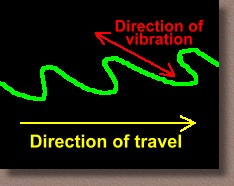
|
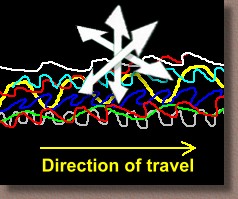
|
Ordinary visible light is a mixture of many kinds of waves. The light that enters your eye is composed of waves of a multitude of different wavelengths.
Each of these different waves vibrates in many different directions as the light travels.
The beam is made up of waves vibrating in all directions, as shown by the white arrows in this diagram.
|

|
We perceive light waves that vibrate horizontally as 'glare'. As light hits a particular portion of the truck's surface and returns to our eye, the waves get polarized. This means that a higher than normal number of them are vibrating horizontally. When this light enters our eye, the large number of horizontally vibrating waves overpower the other waves, and everything near that part of the truck is hidden by the 'glare' caused by the polarized waves.
|
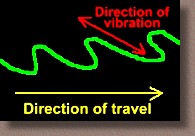
|
This is just one familiar example of light waves that have been polarized. There are many others. Whenever we change a beam of light waves so that many of the waves are vibrating in the same direction, we have 'polarized' the light beam.
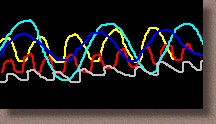
A beam of light where most of the waves
are vibrating the same way (vertically).
How can a beam of light be polarized?
One way is to pass ordinary light, containing waves that are vibrating in all directions, through very thin openings that are aligned in the direction we want the waves to be polarized.
At the right you can see that the waves approaching the barrier are vibrating at oblique angles, and can't get through the vertical slits.
|
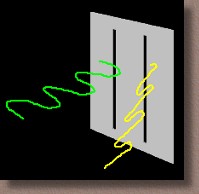
|
Any waves which happen to be vibrating in a direction close to vertical, however, can vibrate right through the opening.
The result will be that the light which comes out the other side will be vibrating mostly up and down; waves vibrating at all the other angles will have been stopped by the barrier. What comes out the other side is called polarized light.
In order to polarize light, we just need to pass it through a barrier
that contains many very narrow slits.
|
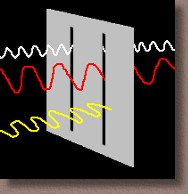
|
In actual situations where we want to polarize light, we often want some of the normal light to get through too, so we can see the object we're looking at. This is achieved by making slits, which are actually long narrow scratches, on a piece of glass. The scratches must be very narrow and close together, because individual light waves are tiny. A bit of normal light can still get through the glass between the scratches, but most of the light is forced to try to vibrate through them ... and only the light vibrating along the length of a 'scratch' can get through.
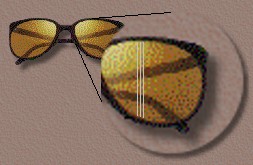
|
In the picture of the polarizing sunglasses at the left, you can see an expanded view of one of the lenses. Although not drawn to scale (you need a microscope to see the scratches), this will give you an idea of how they work. Only light vibrating up and down can easily get through the scratches. Light vibrating in other directions has a hard time getting through. In particular, horizontally vibrating waves will be stopped completely. Since they are the cause of glare, polarizing sunglasses will stop the glare waves, and the truck will look like this:

|
And that's how polarization works! Although this explanation makes sense (we hope), we should point out that the actual description of light waves and how they vibrate is a great deal more complicated than has been made out here. Electromagnetic wave properties can be described mathematically, and seem to share the qualities of both a particle and a wave, as you may have learned in Physics class. However, the way we have visualized them here will do for now, until you learn some more mathematics!
Resources
HTML, graphics & design by Bill Willis 2023
|